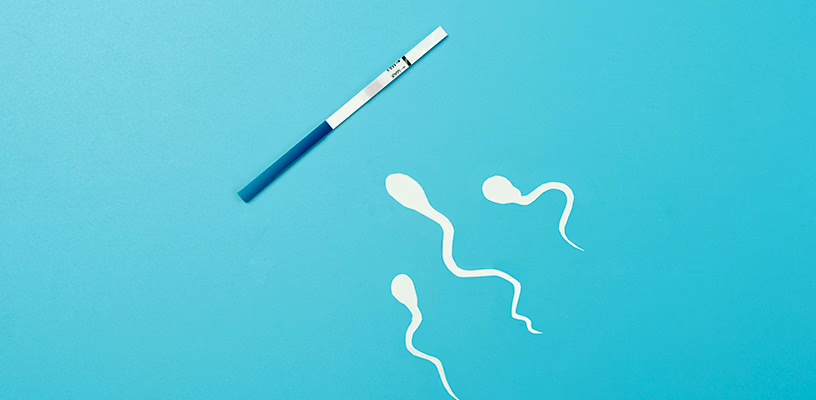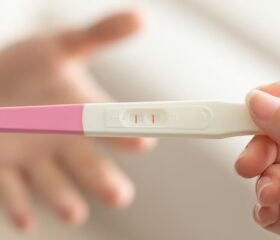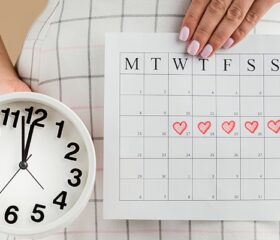Can an Ovulation Test Detect If You’re Pregnant?
Unfortunately, whether or not an ovulation test can detect pregnancy doesn’t have a straightforward yes or no answer.

Occasionally, an ovulation test might detect pregnancy, but that always happens by accident—it isn’t the purpose of an ovulation test. This means an at-home ovulation test strip is not a reliable pregnancy detection tool.
Read on to learn why and how ovulation tests might detect pregnancy, how to use ovulation and pregnancy tests correctly, and which signs suggest you’re ovulating or pregnant.
What’s the difference between an ovulation test and a pregnancy test?
Before we explain why ovulation tests can be positive when you’re pregnant, let’s look at how ovulation tests and pregnancy tests work. While both require you to pee on a stick, they look for different hormones and serve distinct purposes.
Ovulation test strips, or ovulation predictor kits (OPKs), help you determine when you’re about to ovulate and enter the most fertile time of the month. They check the levels of luteinizing hormone (LH) in your urine, which typically surges 1 to 1½ days before ovulation. 1
On the other hand, pregnancy tests tell you exactly what you’d expect: if you’re pregnant. They do this with high accuracy by checking for the presence of human chorionic gonadotropin (hCG) in your urine, which your body produces after fertilization. 2 Generally, by the time you miss your period, there will be enough for at-home pregnancy test strips and digital tests to return a positive result.
Why can ovulation tests be positive when you’re pregnant?
The reason you might get a positive ovulation test (or see a faint positive line on your test) when you’re pregnant is that LH and hCG are closely related and have very similar structures. 3 4
As a result, ovulation tests can sometimes misinterpret hCG for LH and show a positive result when you’re not ovulating but are pregnant.
That said, ovulation tests aren’t designed to detect hCG. It’s just an unintended consequence of how the tests work. This means that a positive ovulation test is by no means a definite sign of pregnancy.
If you want to check if you’re pregnant or not, get a real pregnancy test. Don’t use an ovulation strip as a substitute.
When should you take an ovulation test?
Use ovulation tests for their intended purpose: to find out when you’re due to ovulate.
If you have a regular 28-day cycle, you should start testing around day 11 (i.e., the 11th day after your period started). You may need to test consecutively for a few days before getting a positive result. That’s because there’s a window during which the LH surge may start, usually between days 11–14. 5
To use ovulation testing strips effectively, experts suggest taking the test in the morning when your urine is more concentrated and your LH levels are higher. If you see a positive ovulation test result (i.e., the testing line is as dark or darker than the control line), it means you’ll likely ovulate in the next 24–36 hours. 5
Whether you’re trying to get pregnant or you’re looking to avoid it, know that you’re entering your most fertile period (and, in fact, may already be in it, since sperm can survive in your body for several days and could easily still be viable when your egg is released).
Your chances of getting pregnant will be higher after a positive ovulation test result, so you’ll want to have sex as soon as possible if you want to conceive.
When should you take a pregnancy test?
Women usually take pregnancy tests when they miss their period, either on the expected date or a few days later. Take the test in the morning when your urine and the hormones in it are most concentrated. 2
If you missed your period but got a negative result, try again in a few days to a week. It could be that your hCG levels aren’t high enough to see results yet.
If your test is positive, you’re probably pregnant. The next step is to schedule an appointment with your doctor, who can give you a blood test to check for sure whether you’re pregnant (it’s rare, but at-home pregnancy tests do sometimes return false positives, so it’s good to get confirmation). 6
Always make sure you read the instructions on your home pregnancy test correctly to avoid any ambiguity with the results (e.g., seeing a faint line on your pregnancy test).
Are there other ways to tell if you’re ovulating or pregnant?
Yes, there are signs that suggest you might be ovulating or pregnant. Keep in mind that these vary widely from woman to woman and even pregnancy to pregnancy. You shouldn’t rely on them to determine if you’re ovulating or pregnant.
Common ovulation signs
Many women have physical ovulation symptoms. For example, some find that their cervical mucus becomes clearer and more slippery, with a color and texture that’s usually compared to raw egg whites (in fact, it’s often referred to as egg white discharge).
Along with this ovulation discharge, you might also experience: 2 7 8
- Mild cramps
- Light spotting
- Increased libido
- Breast tenderness
- Bloating
If you want to further narrow down when you’re most likely to ovulate (and whether the symptoms you’re experiencing are caused by it or not), using an online tool like an ovulation calculator can help.
Tracking your basal body temperature to predict ovulation
There are women who track their basal body temperature (BBT) to figure out if they’re ovulating. The idea is that your BBT slightly increases during ovulation.
However, there’s limited scientific evidence for this method—according to various studies, the way a woman’s menstrual cycle affects her BBT is unpredictable, making this method of tracking ovulation unreliable. 9 10 11
Common early pregnancy signs
A missed or late period is often the first pregnancy sign women notice. However, there are many other early pregnancy symptoms that may crop up.
Many women experience light spotting shortly after they become pregnant. This is known as implantation bleeding, which will cause your pregnancy discharge to turn brown, pink, or red. Not all women experience this, so it’s nothing to be alarmed about if you don’t have it.
Other common symptoms to look out for include: 12 13
- Breast pain, tenderness, or swelling
- Nausea and vomiting (often in the morning)
- Headache
- Backache
- Fatigue
- Heartburn or constipation
- Lightheadedness
- Frequent urination
- Cravings or distaste for specific foods
- Mood swings
- Weight gain or loss
Final thoughts
Although an ovulation test can return a positive result if you’re pregnant (but not ovulating), that isn’t a reliable method to detect pregnancy. Again, it’s best to use both types of tests for their intended purpose.
If you suspect you’re pregnant, the best thing to do is to wait until you miss your period, then take a urine pregnancy test at home or a blood test at your doctor’s office.
Article Sources
- U.S. Food & Drug Administration. "Ovulation (Urine Test)" Retrieved May 5, 2025.
- MedlinePlus. "Pregnancy test" Retrieved May 5, 2025.
- U.S. Food & Drug Administration. "Guidance for Over-the-Counter (OTC) Human Chorionic Gonadotropin (hCG) 510(k)s - Guidance for Industry and FDA Reviewers/Staff" Retrieved May 5, 2025.
- Gynecological Endocrinology. "Luteinizing hormone and human chorionic gonadotropin: distinguishing unique physiologic roles" Retrieved May 5, 2025.
- MedlinePlus. "Ovulation home test" Retrieved May 5, 2025.
- Office on Women's Health. "Pregnancy tests" Retrieved May 5, 2025.
- Office on Women's Health. "Your menstrual cycle" Retrieved May 5, 2025.
- University of Utah Health. "Ovulation: When Is the Best Time to Get Pregnant?" Retrieved May 5, 2025.
- Fertility and Sterility. "Accuracy of Basal Body Temperature for Ovulation Detection" Retrieved May 5, 2025.
- Fertility and Sterility. "Basal body temperature: unreliable method of ovulation detection" Retrieved May 5, 2025.
- Fertility and Sterility. "Inaccuracy of basal body temperature charts in predicting urinary luteinizing hormone surges" Retrieved May 5, 2025.
- South Dakota Department of Health. "Early Signs of Pregnancy" Retrieved May 5, 2025.
- Office on Women's Health. "Stages of pregnancy" Retrieved May 5, 2025.







